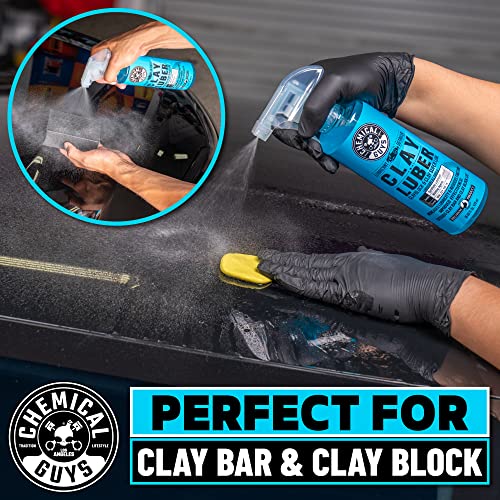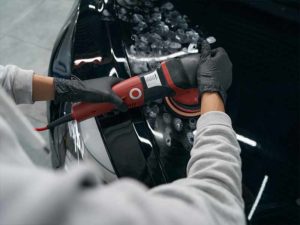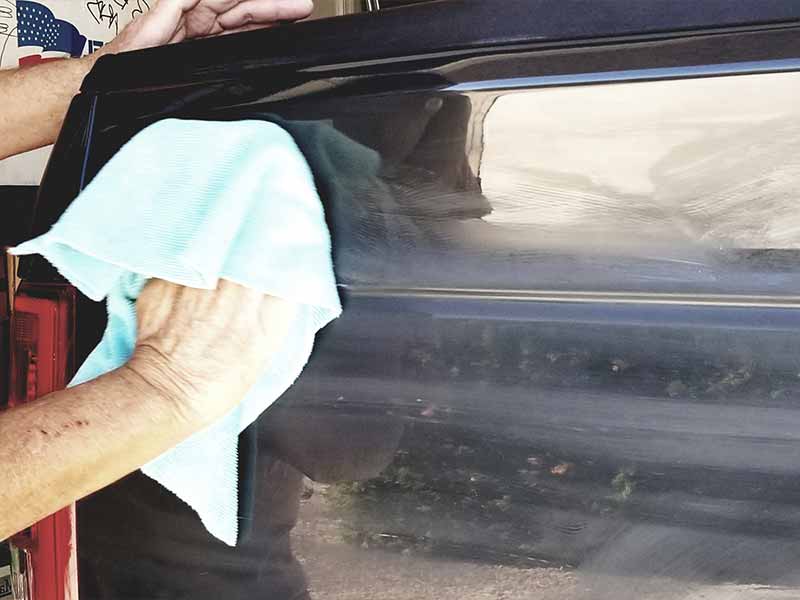Table of Contents
Ceramic coatings are amazing paint protection products. A ceramic coated car has amazing hydrophobic properties, makes keeping your car clean easier, it shines better than almost anything else, and can even help prevent light scratches and swirls in your finish.
The higher durability of a ceramic coating requires some prep work to ensure that the coating bonds properly with the vehicle’s paint.
Can You Put Ceramic Coating Over Wax?
No. A ceramic coating needs to be applied directly to the painted surface.
Any old wax, paint sealants, dirt, or other contaminants will prevent the ceramic coating from creating a chemical bond with the car’s paint and negatively impact the durability of the ceramic coating.
Ceramic Coating Vs Ceramic Spray Coating
The term “ceramic” has become used quite a bit overused in the detailing world as marketing hype. It should be noted that a ceramic spray is not the same as a ceramic coating. If you’re looking for the true benefits of a quality ceramic coating, make sure you know what you’re buying.
There are several great ceramic coatings on the market. A good one we recommend is Gtechniq Crystal Serum Light. It’s one of the easier to use ceramic coatings and performs incredibly well.
How To Prep For Ceramic Coating
When applying ceramic coating, it needs to properly bond with the car’s paint to provide long lasting protection. This means the surface of your finish needs to be completely free of any old protection such as car wax or sealant.
It also needs to be as clean as possible from other contaminants as well. There should be no environmental contaminants on the surface of the clear coat and it should be residue free.
The following steps should be followed thoroughly to ensure that your coating bonds properly with the paint’s surface.
Step One – Wash
The prep process should begin with a thorough wash. The best method for washing your car to prevent accidental swirl marks and light scratches is the two bucket method. This is a process that helps prevent collecting dirt and grit on your wash mitt and rubbing them across the surface of your vehicle’s paint and causing scratches on the surface of the clear coat.
If you’re unfamiliar with the two bucket method, essentially you have two wash buckets, one with soapy water and one with rinse water. Load your wash mitt up with soapy water and wash a section of your car. When done with that section, rinse your wash mitt in the rinse bucket to allow any dirt and grit that collected on it to fall out into the bucket.
The use of grit guards in your bucket creates a barrier that prevents your wash mitt from reaching the bottom of the bucket and picking the grit back up onto the mitt during the wash process.
There’s more to the process and I’d recommend reading our detailed article about the two bucket process before you begin.
Step 2 – Decontaminate
The most common method of decontamination is clay barring. A clay bar is a literal bar of a synthetic clay that is glided across the surface of your paintwork with the aid of a lubricant. The clay bar pulls out contaminants that are adhered to the finish that a car wash can’t remove.
Common contaminants that a clay bar removes are brake dust, industrial fallout, insect guts, road tar, tree sap, etc. A lot of these contaminants are very small and not visible to the naked eye. After using a clay bar on the finish of a car that has a good amount of contaminants will turn the clay bar surface black. You’ll be surprised at the results.
A common method of testing whether you need to clay bar your paint is the baggie test. By placing your hand in a plastic bag and gliding your finger tips over the surface of your paintwork you can feel whether your finish is glassy smooth or slightly rough like sandpaper.
Step 3 – Polish
Polishing is meant to remove any light scratches or swirl marks before applying a ceramic coating that will last several years. This process is commonly referred to as paint correction.
The most efficient method of polishing your car is to use a dual action polisher. Many beginner detailers are hesitant to use a machine polisher for fear of burning through the clear coat, but DA polishers are extremely gentle and very beginner-friendly.
You can learn more about polishing out fine scratches and swirls in our article on the 3-step paint correction process.
Step 4 – Degrease
One last step that is smart to perform before an attempt to apply ceramic coating is to degrease the entire surface of the car’s paint to remove any leftover waxes, polish, or other oils that may prevent the ceramic coating from bonding properly with the vehicle’s paint.
Cleaners often used to degrease the paintwork are Panel Wipe by Gtechniq or a DIY isopropyl alcohol dilution.
We should also mention that the only fabric material that should come into contact with the surface of your clear coat is a microfiber towel. Microfiber is extremely gentle and is the least likely material to cause light scratches on the surface.

How To Remove Wax Before Ceramic Coating
If your primary concern is removing car wax before applying a ceramic car coating, the key steps above that will remove carnauba wax or sealant from the finish are clay bar and degreaser. Carnauba wax is generally easier to remove but a paint sealant can be slightly more tenacious.
Polishing will obviously also remove anything on the surface since it is literally removing a thin layer from the surface of the clear coat. Its main purpose is removing fine scratches and light swirls. If you’re dealing with a new car or one that has been recently paint corrected, you can skip this step.
Both clay barring and an IPA wipe down will remove old wax and paint sealant and leave the paintwork perfectly clean.

Difference Between Wax And Ceramic Coating
Ceramic coatings and waxes are alike in many ways but are lightyears different in their performance and ability to provide protection to your car’s paint.
Also, the term wax has become a catch-all term that includes both natural carnauba wax and paint sealant.
Let’s break down the pros and cons of each of these paint protection products.
Pros And Cons Of Waxes
Natural carnauba waxes are the original paint protection. While a natural carnauba wax can create a thin protective layer between the paint surface and the elements, it isn’t very durable and will wear away within a month under typical conditions.
Using a carnauba wax for paint protection will require reapplication monthly for it to be worthwhile. It also doesn’t have many of the benefits of more advanced paint protection products. It does have a rich, glossy depth that is difficult to match.
Pros And Cons Of Paint Sealants
Paint sealants are usually what people mean when they say “wax”. Paint sealants are synthetic polymers that have been designed to create a more durable bond with the vehicle finish, have improved hydrophobic properties, and incorporates UV inhibitors to help slow the damaged caused by ultraviolet radiation from the sun.
The best paint sealants can last longer than a year which is pretty amazing and make them an excellent choice for most car enthusiasts.
Pros And Cons Of Ceramic Coatings
Ceramic coatings are advanced nano ceramic coatings that permanently bond with the paint surface. These coatings are extremely durable and a professional grade ceramic coating can last more than 10 years. Even consumer grade coatings are approaching 10 years of protection.
Not only that, but the water beading properties are unsurpassed by any other product. This means your car will stay looking cleaner longer, be easier to clean when it does need to be washed, and shine better than anything else.
The hydrophobic abilities and the shine do fade over time even though the coating itself remains to protect the finish beneath. Ceramic coating manufacturer’s make “toppers” that are used to restore these benefits from time to time as needed.
The last benefit that waxes and sealants don’t begin to offer is scratch resistance. A ceramic coating is able to prevent micro scratches and swirl marks that dull your finish over time. It can even help prevent a small stone chip or two. This benefit shouldn’t be oversold though. A ceramic coating can’t prevent someone from keying your car or prevent the vast majority of rock chips.
The big downsides to ceramic coatings are the cost, which is mostly involved in paying for labor if you don’t apply the coating yourself. The other downside is that it’s smart to perform paint correction before applying a ceramic coating, which is also labor-intensive and expensive if you don’t do it yourself.

Helpful Links
Conclusion
Ceramic coatings are great, but they can’t be applied over wax or any other products on the surface of your paint. You need to strip and clean paintwork to ensure that the surface is completely free of anything that will get between the ceramic coating and the paint.
Hopefully you’ve found this article informative. We encourage you to check out some of our other articles, especially our comprehensive guide to detailing a car, and continue learning about car detailing.









